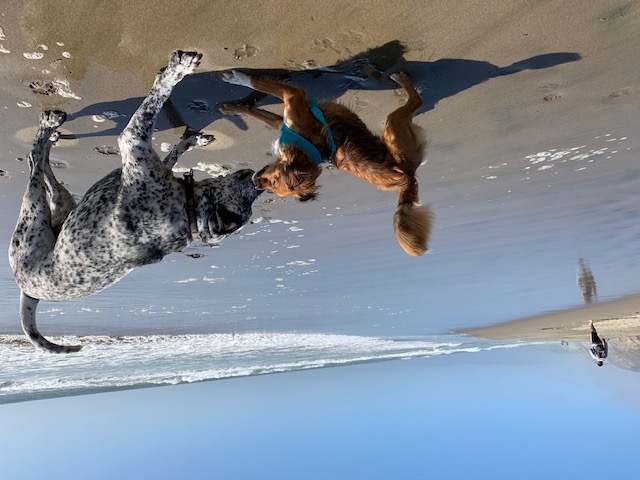Mind Your Manners: How to Say Hello Doggy-Style

There are 76 million dogs in the United States, and fifty-three percent of households include a dog. In the Bay Area, dogs are everywhere. It’s impossible to walk down the street or visit a local park without seeing at least a few dogs. And yes, it’s true, San Franciscans have more dogs than children. Whether your dog is a young social butterfly or a nervous introvert, your dog needs help maneuvering through our human world of sidewalks, leashes, and parks. Do you know how to safely introduce your dog to new dogs?
On-leash greetings should be very short (a few seconds) or avoided entirely. Leashed dogs cannot display normal greeting behaviors, and they cannot choose whether they want to play with or avoid other dogs. Next time you’re at a park with unleashed dogs, pay attention to how they interact. Some dogs will ignore or avoid each other. Those that do choose to say hello will politely arc around each other before sniffing butts. Canine greetings are a delicate dance filled with subtle body language. Being on a leash interferes with this canine protocol. When humans greet, it’s considerate to stand face-to-face and look each other in the eye. When dogs meet this way, it’s a provocation.
When on leash, maintain space between your dog and passing dogs. Leashed greetings can be stressful for your dog, so if you do encounter another dog up-close, resist tightening up on the leash, as this can create tension or frustration. Allow the dogs to sniff for the count of 3 and move on. My dog is pretty chill, but when we meet other dogs, I will always drop his lead so he can choose how and if he wants to interact.
If your dog is off-leash, do not let them approach leashed dogs. It’s unfair to both the dog and the owner; the leashed dog may be reactive, injured, or just trying to pass unnoticed. Just because your dog is friendly doesn’t mean it’s okay to say hello to every dog they see. “Under voice control” is expected in off-leash areas. This means that your dog will come when called. You are at fault if your unleashed dog gets in a scuffle with a leashed dog.
When meeting new dogs, avoid confined spaces, so the dogs don’t feel trapped. Outside, open areas are always preferable to inside or at tiny dog parks. Pick in advance which dogs you will greet. You should call out to other dog owners ("okay to say hi?") before meeting an unknown dog. Your dog can probably sense if you are anxious, so set the mood by staying calm and using an upbeat, happy voice.
Make sure the leash is loose, or drop the lead and let it drag while you assess the encounter. Watch both dogs for signs of tension; look for stiff posture, hard staring, or freezing. Standing over and placing a chin (or paw) over the back of another dog’s neck or shoulder is a direct provocation that can lead to a fight. Just because tails are wagging doesn’t mean everyone is happy. Stiff, vertical, staccato wags, or very slow wags can indicate that your dog is anxious. A low or tucked tail wag signals fear and uncertainty.
Do not let your dog run full speed at unknown dogs. This is bad manners in dog society and could start a fight. Teach your dog to approach new dogs with a steady and slow approach before they begin engaging in the sniffing protocol. If your dog is in the habit of approaching new dogs with too much exuberance, keep them leashed and use treats or a toy to distract and lure until they are closer to the other dog.
If your dog is social and friendly when off-leash - but lunges and barks at other dogs when leashed (or when behind a fence or inside the car) - this is likely due to barrier frustration or overexcitement. This behavior won’t go away on its own, so reach out to a force-free dog trainer or behavior consultant for help.
Dogs are social species, but your pup isn’t broken if they prefer not to socialize with other dogs. All dogs, regardless of breed, have distinct personalities and preferences. Some are gregarious and playful, and some are shy and tentative. If your dog mostly ignores other dogs and prefers sniffing, that’s okay. Don’t force interactions. It is also normal for your dog to become less interested in playing with other dogs as they get older.
If your dog growls, lunges, or snaps when they see or meet other dogs, reach out to a force-free trainer for help.
You wouldn’t put toddlers in a room, walk away, and hope no one loses an eye. The same goes for dogs. Always monitor play between dogs to ensure they don’t get overstimulated and to interrupt questionable or inappropriate play. Crowded dog parks with distracted humans staring at their phones are a recipe for disaster.
Practice calling your dog away from play and taking breaks. Dog play can get pretty rowdy, so learn how to recognize appropriate play. Know how to read your dog’s body language and step in when your dog needs help. There’s no greater joy than watching dogs play, and when my dog is happy, I’m happy.

